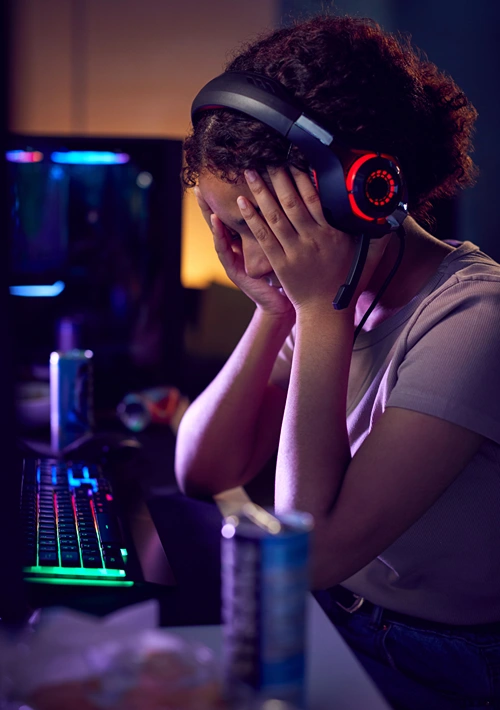Internet Addiction: Signs, Effects, and Recovery Approaches for Families
Internet connectivity has transformed how we work, learn, communicate, and entertain ourselves, bringing remarkable benefits to our daily lives. However, this connectivity has also given rise to internet addiction, a behavioral dependency affecting people across all age groups and backgrounds.
This guide explores the warning signs of problematic internet use in children and teens, its consequences on developing minds, and effective approaches families can implement together for healthier digital habits.
Understanding Internet Addiction in Young People
Internet addiction, also called problematic internet use (PIU), describes patterns of excessive online activity that interfere with daily functioning and cause significant distress. Unlike occasional overuse, addiction involves dependency characterized by an inability to control online activities despite negative consequences.
Common Types of Internet Addiction Affecting Youth
Children and teens are particularly vulnerable to several forms of internet dependency:
- Gaming addiction: Excessive engagement in online games affecting school performance
- Social media addiction: Compulsive checking and posting on networking platforms
- Information overload: Uncontrollable web surfing affecting focus and attention
- Online relationship dependency: Excessive involvement in virtual relationships
- Video streaming obsession: Inability to stop watching online content
Warning Signs Parents Should Watch For
Psychological Signs
Parents and educators should be alert to these psychological indicators:
- Preoccupation with internet activities even when offline
- Irritability, anxiety, or depression when internet access is restricted
- Needing increasing amounts of time online to achieve satisfaction
- Unsuccessful attempts to control or reduce use
- Diminished participation in once-enjoyable offline activities
Behavioral Changes
Observable behavior patterns often accompany problematic internet use:
- Declining academic performance or neglect of homework
- Disrupted sleep patterns from late-night online activities
- Secretive behavior about online activities
- Withdrawal from family interactions and face-to-face friendships
- Defensiveness when questioned about screen time
- Losing track of time when using devices
Physical Symptoms
Extended excessive internet use can manifest in physical ways:
- Eye strain, including blurry vision and headaches
- Poor posture resulting in neck and back discomfort
- Sleep disturbances affecting daytime alertness
- Reduced physical activity leading to fitness concerns
- Irregular eating patterns during extended screen sessions
Effects of Internet Addiction on Child Development
Cognitive Impact
Internet addiction can significantly affect developing minds:
- Reduced attention span for non-digital activities
- Difficulty with deep reading and sustained concentration
- Delayed development of critical thinking skills
- Diminished creativity and problem-solving abilities
Social Development Concerns
Excessive internet use can hinder essential social growth:
- Limited development of face-to-face communication skills
- Reduced empathy from fewer in-person interactions
- Difficulties interpreting non-verbal social cues
- Missing opportunities for collaborative play and cooperation
Academic Consequences
School performance often suffers significantly:
- Incomplete assignments and homework
- Reduced class participation
- Lower standardized test scores
- Missed learning opportunities from distracted engagement
Family-Centered Recovery Approaches
Creating Healthy Boundaries
Effective family strategies include:
- Establishing tech-free zones like dining rooms and bedrooms
- Setting specific times for internet use with clear limits
- Implementing device-free family activities and outings
- Using parental control tools that provide visibility into children’s online activities
- Creating a family media agreement with clear expectations
Digital Wellness Tools
Several resources can support healthier internet habits:
- Screen time management apps that track and limit usage
- Internet Matters provides family safety resources and guides
- Content filtering tools that restrict access to problematic content
- Connect Safely offers family resources for online safety
Building Digital Literacy
Empowering children with knowledge helps prevent problematic use:
- Teaching critical evaluation of online content
- Discussing digital citizenship and responsible online behavior
- Explaining how social media and games are designed to be addictive
- Promoting awareness of how excessive use affects brain development
Prevention Strategies for Parents and Educators
Early Education Approaches
Prevention begins with proactive education:
- Age-appropriate discussions about healthy technology use
- Modeling balanced digital habits for children to observe
- Developing diverse offline interests and activities
- Encouraging regular physical activity and outdoor time
- Teaching mindfulness and self-regulation techniques
School-Home Partnership
Collaborative approaches strengthen prevention efforts:
- Consistent screen time expectations between home and school
- Regular communication about digital behavior concerns
- Shared resources for addressing problematic internet or mobile phone use
- Combined monitoring of online activities and patterns
When to Seek Professional Help
Some situations require additional support:
- When a child’s internet use consistently disrupts family functioning
- If academic performance shows significant decline
- When behavioral changes indicate emotional distress
- If physical health issues develop from excessive use
- When self-implemented strategies prove ineffective
Professional interventions might include:
- Family therapy focused on digital habits
- Cognitive-behavioral approaches for compulsive internet use
- Treatment for co-occurring issues like anxiety or depression
- Specialized programs for technology addiction
Creating Balance in a Digital World
Recovery doesn’t mean eliminating technology—it means establishing a healthier relationship with it. By recognizing early warning signs, implementing family-centered strategies, and seeking help when needed, parents can guide children toward digital wellness that enhances rather than detracts from their development and wellbeing.
With appropriate boundaries, education, and support, families can navigate the digital landscape together, ensuring that technology remains a tool that enriches lives rather than controls them.




